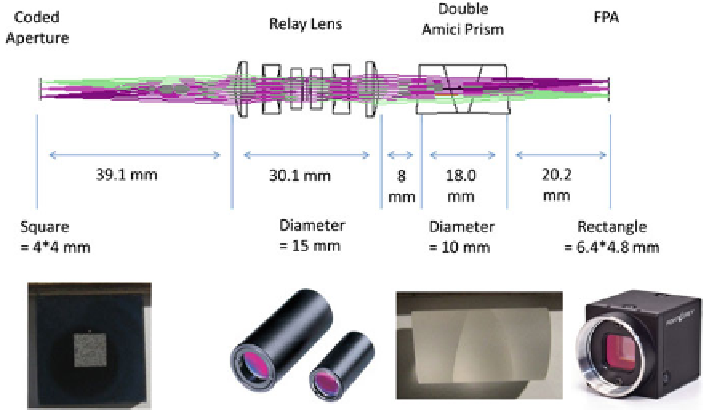Graphics Reference
In-Depth Information
Fig. 13.2
CASSI's optical design and components: coded aperture with 200 by 200 pixels, relay
lens, double amici prism, and FPA
reconstructed by computationally inverting the linear model. Abinary randompattern
is used to encode the spectral datacube into 2D imagery without critical information
loss. To decode the compressed datacube, a sparse optimization is used to alleviate
the underdetermined problem. The sparse optimization imposes spatial and spectral
sparsity constraints on plausible solutions, resulting in the most optimal among them.
CASSI is optically designed and implemented to support the computational
design. In Fig.
13.2
, a collected optical field is modulated by the coded aperture
in the frontend and the modulated field is one-to-one imaged onto the focal plane
array (FPA) by a microscopic relay lens. In the optical path, a double amici prism dis-
perses the spectral channels simultaneously. The coded aperture is designed by 200
by 200 pixels with 19.8
feature size resulting in 4 by 4mm field-of-view (FOV).
The double amici prism is used as an aberration free dispersive element to trans-
form the spectral distribution to the spatial distribution. The double amici prism is
composed of two different optical materials which compensates the nonlinearity of
spectral dispersion. The total length of the system is 115.4mm whose compactness
is advantageous for compact video imaging.
In the computational design, the measurement model expresses the relationship
between the measurement
g
and the spectral datacube
f
. Since the system matrix
H
is underdetermined, far away from the square form, the condition number of
H
is
very large. The bad condition number makes the inverse problem hard. The sparsity
constraints of CS make the inverse problem well conditioned in the proper basis
such as total variation (TV) [
27
,
28
]. The backward model is the transpose of the
measurement model
H
and the transpose system matrix
H
T
estimates the spatial
distribution of the coded aperture in
g
and combines the multiple estimates
f
∗
.
µ

